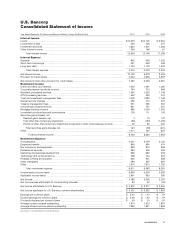US Bank 2011 Annual Report Download - page 80
Download and view the complete annual report
Please find page 80 of the 2011 US Bank annual report below. You can navigate through the pages in the report by either clicking on the pages listed below, or by using the keyword search tool below to find specific information within the annual report.The Company also modifies residential mortgage loans under
Federal Housing Administration, Department of Veterans
Affairs, or other internal programs. Under these programs, the
Company provides concessions to qualifying borrowers
experiencing financial difficulties. The concessions may include
adjustments to interest rates, conversion of adjustable rates to
fixed rates, extension of maturity dates or deferrals of
payments, capitalization of accrued interest and/or outstanding
advances, or in limited situations, partial forgiveness of loan
principal. In most instances, participation in residential
mortgage loan restructuring programs requires the customer to
complete a short-term trial period. A permanent loan
modification is contingent on the customer successfully
completing the trial period arrangement and the loan
documents are not modified until that time. Loans that require
a trial period arrangement are reported as TDRs when offered
to the borrower.
Credit card and other retail loan modifications are
generally part of two distinct restructuring programs. The
Company offers workout programs providing customers
experiencing financial difficulty with modifications whereby
balances may be amortized up to 60 months, and generally
include waiver of fees and reduced interest rates. The
Company also provides modification programs to qualifying
customers experiencing a temporary financial hardship in
which reductions are made to monthly required minimum
payments for up to 12 months. Balances related to these
programs are generally frozen, however, may be reopened
upon successful exit of the program, in which account
privileges may be restored.
Modifications to loans in the covered segment are similar
in nature to that described above for non-covered loans, and
the evaluation and determination of TDR status is similar,
except that acquired loans restructured after acquisition are
not considered TDRs for purposes of the Company’s
accounting and disclosure if the loans evidenced credit
deterioration as of the acquisition date and are accounted for
in pools. Losses associated with the modification on covered
loans, including the economic impact of interest rate
reductions, are generally eligible for reimbursement under loss
sharing agreements with the FDIC.
Impaired Loans For all loan classes, a loan is considered to
be impaired when, based on current events or information, it
is probable the Company will be unable to collect all amounts
due per the contractual terms of the loan agreement. Impaired
loans include all nonaccrual and TDR loans. For all loan
classes, interest income on TDR loans is recognized under the
modified terms and conditions if the borrower has
demonstrated repayment performance at a level
commensurate with the modified terms over several payment
cycles. Interest income is not recognized on other impaired
loans until the loan is paid off.
Factors used by the Company in determining whether all
principal and interest payments due on commercial and
commercial real estate loans will be collected and therefore
whether those loans are impaired, include but are not limited
to, the financial condition of the borrower, collateral and/or
guarantees on the loan, and the borrower’s estimated future
ability to pay based on industry, geographic location and
certain financial ratios. The evaluation of impairment on
residential mortgages, credit card and other retail loans is
primarily driven by delinquency status of individual loans or
whether a loan has been modified. Individual covered loans,
whose future losses are covered by loss sharing agreements
with the FDIC that substantially reduce the risk of credit
losses to the Company, are evaluated for impairment and
accounted for in a manner consistent with the class of loan
they would have been included in had the loss sharing
coverage not been in place.
Leases The Company’s lease portfolio consists of both direct
financing and leveraged leases. The net investment in direct
financing leases is the sum of all minimum lease payments and
estimated residual values, less unearned income. Unearned
income is recorded in interest income over the terms of the
leases to produce a level yield.
The investment in leveraged leases is the sum of all lease
payments, less nonrecourse debt payments, plus estimated
residual values, less unearned income. Income from leveraged
leases is recognized over the term of the leases based on the
unrecovered equity investment.
Residual values on leased assets are reviewed regularly
for other-than-temporary impairment. Residual valuations for
retail automobile leases are based on independent assessments
of expected used car sale prices at the end-of-term.
Impairment tests are conducted based on these valuations
considering the probability of the lessee returning the asset to
the Company, re-marketing efforts, insurance coverage and
ancillary fees and costs. Valuations for commercial leases are
based upon external or internal management appraisals.
When there is impairment of the Company’s interest in the
residual value of a leased asset, the carrying value is reduced
to the estimated fair value with the writedown recognized in
the current period.
Other Real Estate OREO is included in other assets, and is
property acquired through foreclosure or other proceedings
on defaulted loans. OREO is initially recorded at fair value,
less estimated selling costs. OREO is evaluated regularly and
any decreases in value along with holding costs, such as taxes
and insurance, are reported in noninterest expense.
Loans Held for Sale
Loans held for sale (“LHFS”) represent mortgage loan
originations intended to be sold in the secondary market and
other loans that management has an active plan to sell. LHFS
are carried at the lower-of-cost-or-fair value as determined on
an aggregate basis by type of loan with the exception of loans
for which the Company has elected fair value accounting,
which are carried at fair value. The credit component of any
writedowns upon the transfer of loans to LHFS is reflected in
loan charge-offs.
78 U.S. BANCORP
























